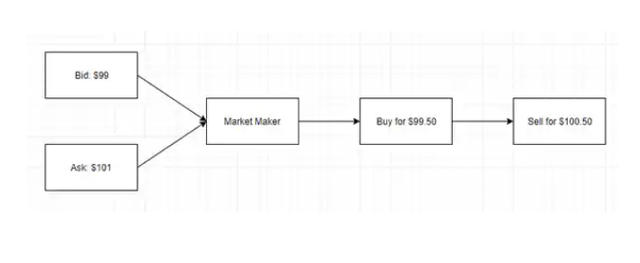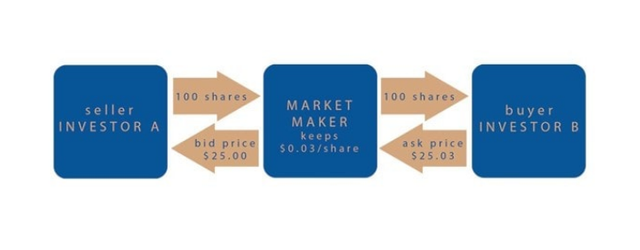[In-depth Study of Market Maker Concept]-Steemit Crypto Academy | S4W6 | Homework Post for @reddileep
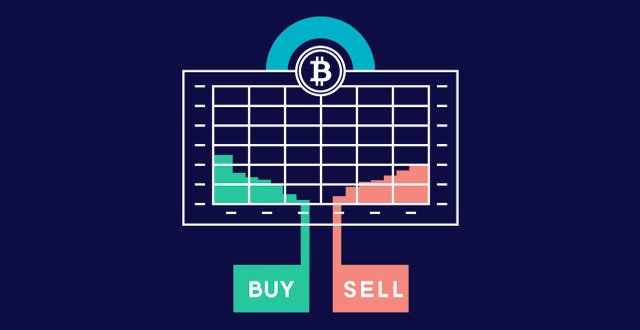 )
)
1- Define the concept of Market Making in your own words.
The Market Making Concept
The market making concept has to do with the provision of liquidity for traders in a market. Just like financial system of today, where large financial institutions create liquidity for their customers and also act as stock brokers, there exist a body in cryptocurrency exchanges, who purchase cryptocurrencies at a price lower than the best bid, and then sell at a price higher than the best ask. They are called market makers.
The sole duty of a market makers is to provide liquidity by buying from sellers and selling for buyers at a rate that will be profitable to them. Therefore market making is an intermediation process of providing liquidity by setting a trade order and a price range, and also buying and selling cryptocurrencies, in order to boost trading volume and also encourage smaller traders to participate in trading.
Liquidity
Liquidity refers to how easy a trader is able to buy and sell an asset at any point in time. If traders in an exchange make an order to buy or sell, and the orders are not filled on time, it means the liquidity of that exchange is low. This is one of the problems of exchanges.However, with the coexistence of market makers, both large volume and small volume of coins can easily be bought at a bid price that is little below that of a best buyer, and sold at an ask price that is a little better than that of a best seller. It therefore means that market makers are third party traders that act as intermediaries, buying and selling at a profit (the spread).
Unlike market takers who are always willing to pay above what they desire, market makers focus on increasing trading volume of a market, and in return, making profits.
Price Positions:
The market making concept also deals with setting a price position which will give a price range for other trades that take place in the market. Although market makers are not in full control of price, they have a role to play in the short run price stability.Duties of market makers
Some of the duties of a market makers are as follows;- They provide liquidity in a market which triggers buying and selling of coins at any time.
- They ensure that price positions are in order and that there is only but minimal deviations.
- They facilitate transparency in trading cost, etc.
2- Explain the psychology behind Market Maker. (Screenshot Required)
The psychology of the market maker concept
Traditionally, there are two parties for each transaction. The buyer and the seller. The market maker concept implies the provision of liquidity in an exchange in order to increase trading seamlessly in that exchange. Now this is how market makers work.
Let's take for instance, in a stock market, if a market maker buys 100 shares at $25 each, and sell at $25.03 each. The market maker makes a profit of $0.03 each. After selling the 100 shares, he will make a total of $3 from the spread.
This is also applicable in the cryptocurrency market. Market makers are present in exchanges to buy coins all the time and sell coins always, such that trading are executed faster than it would be if there were no market makers. Just like in the example of shares, market makers buy cryptocurrencies both in large and small quantities and sell them all the time. This way, buyers do not have to wait for a matching seller and vice versa.
For instance, they can buy a large amount of BTC, say 100 BTC at 54,800 each and sell them at $55,000. The market maker will make $200 each.
Market makers influence prices to a certain degree by setting their own bid and ask prices. In order to quote a suitable price, they make use of the order book.
Apart from the market makers, the whale manipulators also exist as threat to the market makers. They buy in very large volume and hold. Because of this, they are also influential when it comes to price determination. These manipulators sometimes cause smaller investors to panic and sell their assets following wrong signal.
The market maker psychology can be summarised as a third party trading concept, where liquidity is provided in return for a profit known as bid-ask spread.
3- Explain the benefits of Market Maker Concept?
Benefits of Market Maker Concept
There are various advantages of the market maker concept in cryptocurrency trading. They are discussed below;
1. Continuous Price Position: As earlier mentioned, Market makers sets a price position that encourage fast trading.
2. Relatively Fixed Spread: The only spread that traders have to bear is the one that market makers set, there are no extra cost to be borne by buyers or sellers even at volatile periods.
3. Additional offers: Market makers sometimes offer additional benefits such as the trading of fractions which is very specific and essentially for smaller traders.
4. Reduced Price Manipulation: Market making gives a relative stability in the price of assets. Once a market maker sets a price position, individual traders will have to operate within those prices.
5. Market Dominance: Market making increases the liquidity of a market. It is however non-debatable that a market with a high liquidity will dominate and will also attract many traders.
4- Explain the disadvantages of Market Maker Concept?
Disadvantages Of the Market Maker Concept
1. Unfavorable for Large-volume Traders: The market maker concept favors small traders more than large traders as advanced traders tend to incur more losses on spread than those who trade in smaller quantities.
2. Vulnerability to price manipulation: The market maker concept is very vulnerable when it comes to price as market makers sometimes manipulate price signals to ginger selling liquidity. At the end, they will buy at a low price and sell at a higher price.
3. Loss of Assets: Sometimes, supply and demand do not agree with each other. This often result in excessive supply over demand and vice versa. Either way, tokens may be lost in the end.
4. Wider Spread: Market makers sometimes increase the spread because of the profits involved. This will be a loss for traders.
5- Explain any two indicators that are used in the Market Maker Concept and explore them through charts. (Screenshot Required)
Stochastic
The stochastic indicator is a type of momentum based indicator that indicates the closing prices with respect to a previous high-low. This indicator was designed by George Lane to compare previous prices with current closing prices. It measures the speed as well as movements of prices rather than following the volume of trade and price.
Stochastic is an example of a leading indicator because it shows price changes before the actual change occur. Market makers also use stochastic indicator to get bullish and bearish signals and then use this signals to set a price position for current trades.
If the Stochastic indicator shows a bullish signal, market makers can quickly initiate a sell liquidity, where traders will sell their assets and market makers will purchase them and resell when there is a bull.
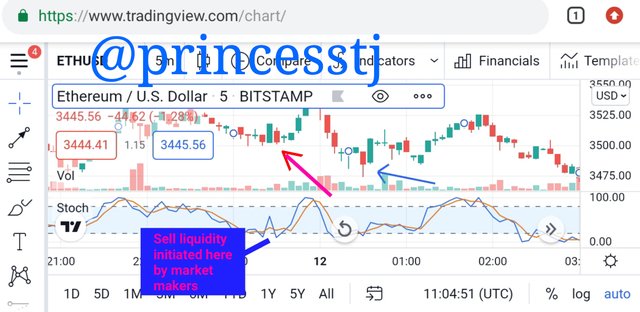 screenshot taken from Tradingview
screenshot taken from Tradingview
In the chart above, the Stochastic indicator is used to monitor the momentum of the market. As indicated, market makers will take advantage of a bullish signal gotten by buying coins immediately even before the bull. Once the bull starts, they sell them at higher price.
Relative strength index
Relative strength index indicator is a type of Oscillator indicator that measures the magnitude and speed of movements of prices. RSI uses figures between 0 and 100 to show if an asset is in overbought or oversold.
Usually, if an asset is overbought, it is expected that prices are up and will be reversed in little or no time. If they are in oversold, it is expected that prices will reverse upward soon.
RSI uses a 14 day, hours, weeks, or monthly interval to indicate overbought and oversold spots. Where there is a rising momentum, RSI will be above 70, therefore showing an active buying situation. When the momentum is falling, RSI will be below 30, meaning that assets are being actively sold.
Market makers use this indicator to know when to start a buy liquidity and when to initiate a sell liquidity. A Relative strength index chart is shown below using the trading information of BTCUSDT pair on Binance.
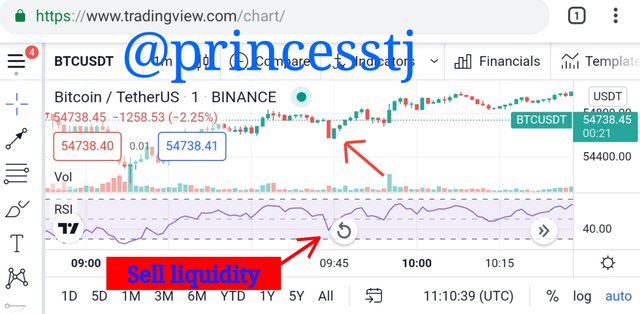 screenshot taken from Tradingview
screenshot taken from Tradingview
From the chart above, the RSI indicator is used to monitor the magnitude and speed of the BTCUSDT pair. From the signals gotten, market makers can buy at oversold. They can as well use that to take some major decisions.
Conclusion
The market maker concept is a good subject to study when it comes to trading. Some traders do not know how buy and sell orders are executed. Sometimes, they do not understand that market makers even exist in the market. From the study of how market makers operate, traders can be cautious of their trading activities especially from the knowledge that market makers are unregulated third parties. They can do their own Technical analysis in order not to be manipulated.
Thank you so much for your time..
